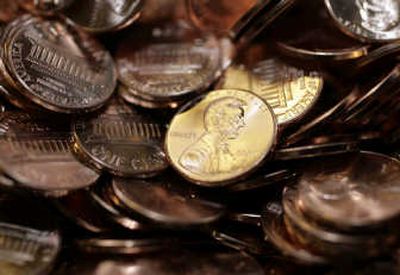Congress weighing steel pennies, nickels

WASHINGTON – That nickel in your pocket costs the government more than 7 1/2 cents to mint.
And a penny cost 1.26 cents as of Tuesday, down from a high of 1.67 cents at the end of 2007 but still a losing proposition.
Surging prices for copper, zinc and nickel have some in Congress trying to bring back the steel-made pennies of World War II, and considering steel for nickels, as well.
“If we continue minting coins with the current metal content, with each new penny and nickel we issue we will also be contributing to our national debt by almost as much as the coin is worth,” said Rep. Luis Gutierrez, D-Ill., who chairs the House panel that oversees the U.S. Mint.
Nickels are made of 75 percent copper and 25 percent nickel, both of which have tripled in price since 2003. Pennies are 2.5 percent copper and 97.5 percent zinc, which has quadrupled in price, Gutierrez said.
Gutierrez estimated that striking the two coins at costs well above their face value set the Treasury and taxpayers back about $100 million last year alone.
A lousy deal, lawmakers concluded as the House moved toward a vote Tuesday that directs the Treasury secretary to “prescribe” – i.e., suggest – a new, more economical composition of the nickel and the penny.
Unsaid in the legislation is the Constitution’s delegation of power to Congress “to coin money (and) regulate the value thereof.”
The Bush administration, like others before, chafes at that.
Just a few hours before the House vote, Mint Director Edmund Moy told House Financial Services Chairman Barney Frank, D-Mass., that the Treasury Department opposes the bill as “too prescriptive” in part because it does not explicitly delegate the power to decide the new coin composition.
The bill also gives the public and the metal industry too little time to weigh in on the new coin composition, he said.
“We can’t wholeheartedly support that bill,” Moy said in a telephone interview. Moy said he could not say whether President Bush would veto the House version in the unlikely event that it survived the Senate.
Sen. Wayne Allard, R-Colo., who is retiring at the end of the year, is expected to present the Senate with a version more acceptable to the administration in the next few weeks.
The proposals are alternatives to what many consider a more pragmatic but politically impossible solution to the penny problem: getting rid of the penny altogether.
“People still want pennies, which is why we’re still making them,” Moy said.
Even Treasury Secretary Henry Paulson acknowledged in a radio interview earlier this year that getting rid of the penny made sense but wasn’t politically doable – and certainly nothing he is planning to tackle during the Bush team’s final months in office.